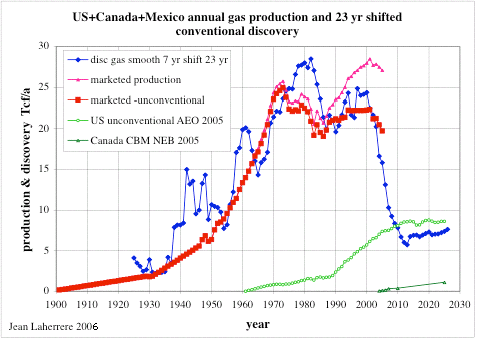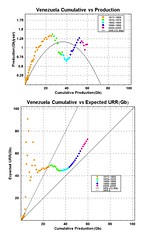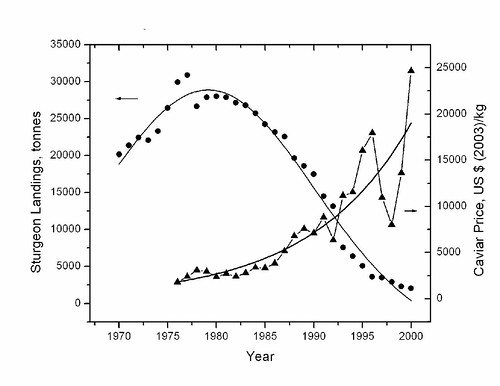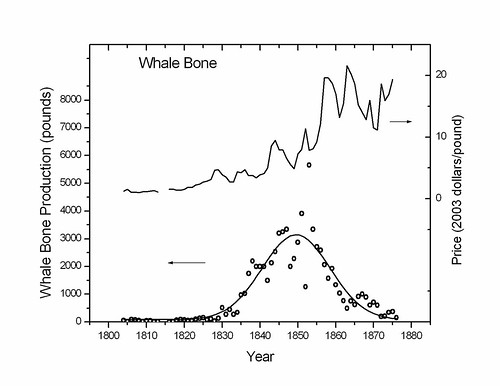TOD:Europe has pulled together data from a recent Laherrere presentation
here. TOD's Luis de Sousa concentrated on Laherrere's USA natural gas analysis and in particular the following chart.

Notice the obvious time-phased shadowing of the discovery curve by the production curve, and the implied reserve depletion that this portends. Albeit, some of the gloom gets abetted by the rise in unconventional NG deposits.
I haven't used the
Oil Shock Model that much to predict natural gas production, partly because of the lack of discovery data and partly because of the supposed abrupt dynamics of natural gas reservoirs (e.g. do they really shut down that quickly at the end of their lifetime?). The latter issue might imply that we can't quite as confidently assume a depletion rate proportional to the volume as a first-order estimate. On the other hand, big reservoirs, like big aquifers, do produce quantitatively more than small ones, so this approximation holds some merit.
It mildly sucks that Laherrere likes to put a filter on his discovery profiles (see above figure, in this case, a 7-year average). The shock model would rather gobble up the raw data and generate a meaningful production profile. Indeed, I have tried it on
New Zealand NG and see no reason that it wouldn't work on USA NG as well, caveats or not.
In any case, given the fact that Laherrere provided
some kind of discovery data, I decided to give the USA conventional NG data a shot with the model. I chose fallow, construction, maturation, and depletion rates of 0.133/year (which is a fairly standard 7.5 year mean, in terms of
oil depletion models) and I got the following dark line fit:

What do the 0.133 numbers physically mean? In a stochastic world, all it means that it takes, on the average, about 7.5 years to start work on a discovered field, 7.5 years to get construction finished, 7.5 years for it to reach maturation, and simultaneously factor in a depletion rate of 0.133 volume per year. The aggregation of these terms causes the discovery profile to shift approximately 23 years (according to Laherrere's opinion) to match the production profile. Understand that this analysis does not necessarily work on individual fields, but to first order (a Markovian process) it does explain everything you need to know on an aggregated set of fields, any one of which can vary according to its own specific parameters (i.e. how long it sat fallow, how long construction took, etc).
The deterministic, or shock, aspects to the model come about when political or economic effects are taken into account. Even though I did not add it to this particular model, rapid changes, due to collusion or world events or technology, can cause the extraction rate to adjust at certain points in the curve. This allows one to get insight into deviations from the general trend.
From the residual errors, you can see max deviations around depression/WWII, 1971, 1984, and 2000 (the stuff before 1920 looks made up as the line looks way too straight). I would consider these candidate time points for introducing changes in the extraction rate. Before doing that, though, I would love to remove that darn 7-year moving average -- like the people imprisoned by the Patriot Act, data needs freedom from shackles!



 I put on new bindings on my clap skates and have had several good outings. Mother nature's layout artist doesn't permit me to get from point A to point B by skates alone, but one can always dream.
I put on new bindings on my clap skates and have had several good outings. Mother nature's layout artist doesn't permit me to get from point A to point B by skates alone, but one can always dream.







 Barry McCaffrey looks displeased. An equally perturbed Edvard Munch screams from Google that CERA has paid money for the top spot on the query "Peak" "Oil". This ends up alerting everyone within earshot that "Peak Oil Theory Flawed".
Barry McCaffrey looks displeased. An equally perturbed Edvard Munch screams from Google that CERA has paid money for the top spot on the query "Peak" "Oil". This ends up alerting everyone within earshot that "Peak Oil Theory Flawed".














 Strange, but if you google the terms "peak" "helium", you will arrive
Strange, but if you google the terms "peak" "helium", you will arrive  Khebab did a great job aggregating various oil depletion models to compare against November production numbers at
Khebab did a great job aggregating various oil depletion models to compare against November production numbers at 
 on this side of the puddle has dried up. I feel happy for all the bloggers and radio hosts who have pushed for progressive candidates the past few years. We should finally see some progressive energy bills coming out of congress the next few years.
on this side of the puddle has dried up. I feel happy for all the bloggers and radio hosts who have pushed for progressive candidates the past few years. We should finally see some progressive energy bills coming out of congress the next few years.


 Sounds like a good idea: cut down the other hardwoods and conifers, then plant and harvest fast-growing poplars which will rapidly leech the soil, initiate strip mining to capture the rest of the locked-in iron ore, and everyone will want to visit and ride on the scenic biking paths. Who wouldn't want to see an imitation lunar landscape, decimated for your convenience and available at a fraction of the cost of the original?
Sounds like a good idea: cut down the other hardwoods and conifers, then plant and harvest fast-growing poplars which will rapidly leech the soil, initiate strip mining to capture the rest of the locked-in iron ore, and everyone will want to visit and ride on the scenic biking paths. Who wouldn't want to see an imitation lunar landscape, decimated for your convenience and available at a fraction of the cost of the original?
 If you consider that any power source has an internal resistance (R1=r) that must eventually get balanced by an external resistive sink (R2=R), the most efficient power transfer occurs when r=R.
If you consider that any power source has an internal resistance (R1=r) that must eventually get balanced by an external resistive sink (R2=R), the most efficient power transfer occurs when r=R. I could put the shoe on the other foot, and think how this would effect me if we turn the tables, and I and my fellow American engineers and scientists became targetted for the same treatment. Echoing Bush, I would say "bring it on". Deep down I believe that technologists that don't pursue rapture-relief objectives have a bit more cajones to stay the course. The other side would sooner piss their pants than support a cause that all their education contraindicates.
I could put the shoe on the other foot, and think how this would effect me if we turn the tables, and I and my fellow American engineers and scientists became targetted for the same treatment. Echoing Bush, I would say "bring it on". Deep down I believe that technologists that don't pursue rapture-relief objectives have a bit more cajones to stay the course. The other side would sooner piss their pants than support a cause that all their education contraindicates.

 Big Gav has
Big Gav has 
 ... Thou anointest my head with oil; My cup runneth over. ...
... Thou anointest my head with oil; My cup runneth over. ...




